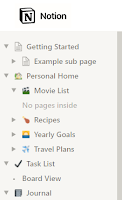Hopefully, you’ve had a chance to play with Notion and all its lovely options. Let’s talk about how the app can make life easier for authors.
The focus of the program is project management. Here is a place to manage your writing career. The Goals template is a great place to start. You can convert it to an extended to-do list for current and future projects. The template has spaces for upcoming, ongoing, and future tasks. Create goals for the year or map out the due dates for projects. The Roadmap template works similarly, giving a great visual of the progress of a project.
I find writing things down helps so much. It might seem redundant or lame to spell out goals or steps. But life is busy, and people forget things. (Like I opened my Goals page and was happily surprised I’d already spelled out my intentions for 2022. I totally didn’t forget I made that list.)
Another useful template is Calendar Content. With this page, you could map out social media posts, planned discount sales, and in-person events (if we ever get there again). A great author class I attended suggested using a calendar such as this one to plan social media content. At the beginning of the month, take a few minutes to jot down your intended marketing items. It will save time in the long run. You can save the images and ad copy for the posts right in Notion. Cut, paste, and you’re done!
One interesting template in the Marketing section is called Brand Assessment. In this template, you can save your logo, banners, ad copy, fonts, avatars, and more. Currently, I’ve been using Google Keep for my collection of hashtags, links for my books, and plot bunnies. By employing Notion for the task instead, I can also add my book covers and ad images. All my social media links, pictures, and marketing material will be in the same place. Then Keep will be just for my plot bunnies and checklists. Perfect!
Another great template in the Marketing folder is the Mood Board. I create a similar board on Pinterest and keep it public. But perhaps as you are plotting (or pantsing), you want to keep your cards close to your chest. The mood board allows you to add pictures, website clips, and videos to visualize your book. Once you’re ready, you can add the content to other social media (or not, as you prefer).
Templates are not the only option for making Notion work for you. Once you become familiar with the app, you can create timelines, databases, name lists, story/series bibles. The sky is the limit.
Notion is diverse enough to handle many author tasks. (It even has an add-on $50 template for making newsletters!) As the program is available on Android and iOS, you can update Notion on the go.
I want to thank all my readers for another great year. Next week, we’ll have a wrap-up and then forward to new apps for 2022.




